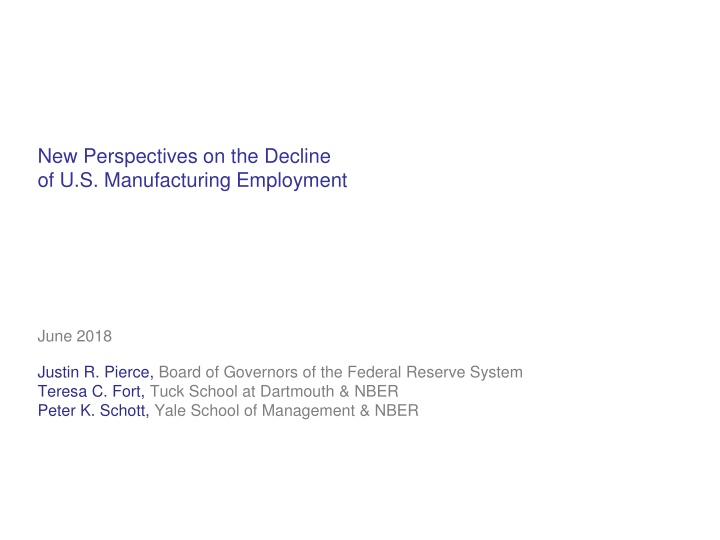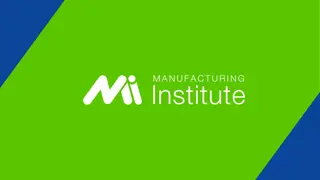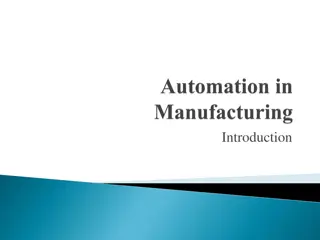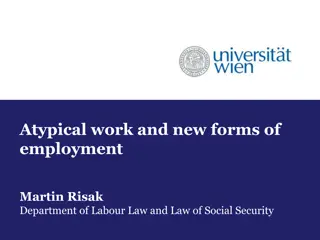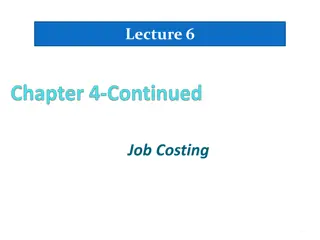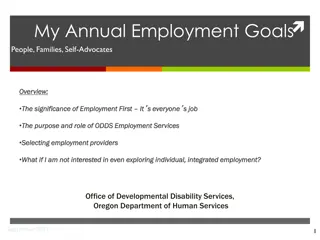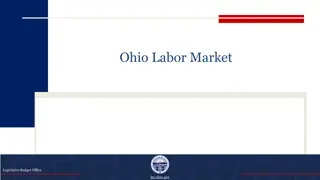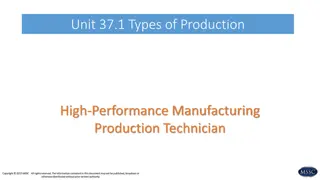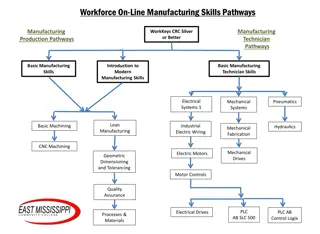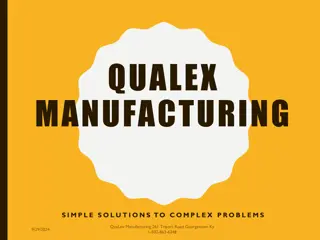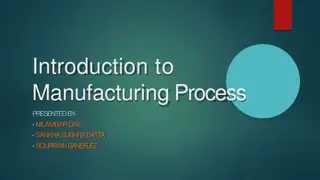Perspectives on U.S. Manufacturing Employment Decline
In a study on the decline of U.S. manufacturing employment, various factors such as import competition from China, foreign sourcing, offshoring, and technology adoption are explored. The complex interplay between trade and technology is examined, highlighting the challenges of disentangling their effects on employment. The difficulty of distinguishing trade versus technology influence is underscored by real-world examples.
Download Presentation

Please find below an Image/Link to download the presentation.
The content on the website is provided AS IS for your information and personal use only. It may not be sold, licensed, or shared on other websites without obtaining consent from the author.If you encounter any issues during the download, it is possible that the publisher has removed the file from their server.
You are allowed to download the files provided on this website for personal or commercial use, subject to the condition that they are used lawfully. All files are the property of their respective owners.
The content on the website is provided AS IS for your information and personal use only. It may not be sold, licensed, or shared on other websites without obtaining consent from the author.
E N D
Presentation Transcript
New Perspectives on the Decline of U.S. Manufacturing Employment June 2018 Justin R. Pierce, Board of Governors of the Federal Reserve System Teresa C. Fort, Tuck School at Dartmouth & NBER Peter K. Schott, Yale School of Management & NBER
Disclaimer Any opinions and conclusions expressed herein are those of the authors and do not necessarily reflect the views of the U.S. Census Bureau, the Board of Governors or its research staff. All results have been reviewed to ensure that no confidential information has been disclosed. 2
US Manufacturing Employment is Declining Manufacturing Employment 1948-2018 20 -12% 18 Manufacturing (Mill) -17% 16 14 -18% 12 1948 1958 1968 1978 1988 1998 2008 2018 Manufacturing 3
Manufacturing Employment vs Real Value Added Manufacturing Employment vs Real Value Added 1948-2018 20 3 Log Real Value Added (USD Trillion) 18 Manufacturing (Mill) 16 1.5 14 12 .75 1948 1958 1968 1978 1988 1998 2008 2018 Manufacturing Real Value Added 4
Explanations? Import competition, especially from China in 2000s Bernard, Jensen and Schott (2006), Autor, Dorn and Hanson (2013), Acemoglu et al. (2016), Pierce and Schott (2016), Autor et al. (2016), Caliendo et al. (2017) Foreign sourcing and offshoring Harrison and McMillan (2011), Antras, Fort and Tintelot (2017), Boehme, Flaaen and Pandalai-Nayer (2017), Kovak, Oldenski and Sly (2018) Technology adoption and automation Autor, Levy and Murname (2003), Autor and Dorn (2013), Acemoglu and Restrepo (2017), Graetz and Michaels (2017) 5
Can We Distinguish Trade vs Technology? Some papers attempt to disentangle these two forces Goos, Manning, Solomans (2014): technology polarization ADH (2015): trade matters most for employment loss after 2000 But technology facilitates trade and product fragmentation Bloom et al (2016), Fort (2017), Autor et al. (2017), Steinwender (2018), Juhasz and Steinwender (2018) And, trade can induce or reduce technology and R&D investment Bernard et al. (2006), Khandelwal (2013), Boler et al. (2015), Bloom et al. (2016), Bernard et al. (2018), Autor et al. (2017) 6
Disentangling Trade/Technology is Very Difficult Wall Street Journal 2017.3.16 When Drew Greenblatt bought a small Baltimore maker of wire baskets for bagel shops, he knew nothing about robotics. That was 1998, and workers made products manually using 1950s equipment . 7
Disentangling Trade/Technology is Very Difficult Wall Street Journal 2017.3.16 When Drew Greenblatt bought a small Baltimore maker of wire baskets for bagel shops, he knew nothing about robotics. That was 1998, and workers made products manually using 1950s equipment . Pushed near insolvency by Chinese competition in 2001, he started investing in automation. Since then, Marlin has spent $5.5 million on modern equipment. Its revenue, staff and wages have surged and it now exports to China and Mexico. Were the changes at Marlin driven by trade or technology? What about changes at Marlin s US competitors? Did Marlin import its robots? 8
Industry Import Penetration Importing and Technology Adoption Import penetration starts rising in the 1980s 1977-2012 60 Chinese import penetration accelerates after 2000 40 Percent Import penetration from China Industry import penetration 20 0 1977 1982 1987 1992 1997 2002 2007 2012 Import Penetration China Import Penetration Importers Importers from China Computers Electronic Networks 9
Firm-Level Importing Importing and Technology Adoption Import penetration starts rising in the 1980s 1977-2012 60 Chinese import penetration accelerates after 2000 40 Percent Firms that import 20 Firms importing China 0 1977 1982 1987 1992 1997 2002 2007 2012 Import Penetration China Import Penetration Importers Importers from China Computers Electronic Networks 10
Firm-Level Technology Importing and Technology Adoption Large increase in share of plants using computers in the early 2000s 1977-2012 60 Purchasing computers 40 Percent Use of electronic networks to control and coordinate shipments also rising during that period Using 20 electronic networks 0 1977 1982 1987 1992 1997 2002 2007 2012 Import Penetration China Import Penetration Importers Importers from China Computers Electronic Networks 11
Trade and Technology Move Together! Importing and Technology Adoption Over our sample period, firms use of trade and technology both rise! 1977-2012 60 40 Percent Hard to disentangle 20 Goal in this paper is to highlight new dimensions of employment loss to gain deeper insights 0 1977 1982 1987 1992 1997 2002 2007 2012 Import Penetration China Import Penetration Importers Importers from China Computers Electronic Networks 12
We Examine Three Margins of Adjustment Industry-level Few clear examples of sunrise and sunset industries Trade shocks affect outputs AND inputs Firm-level 75% of decline occurs in continuing firms! NM growth offsets M declines before 2000! Region-level Pre-2000, manufacturing employment moves west and south After 2000, it falls everywhere 13
Outline Industry margins of adjustment Firm margins of adjustment Regional margins of adjustment Conclusion 14
Sunset, Sunrise Industries Exist, But are Scarce Leather, Apparel: employment and output both fall In most sectors, output rises as employment falls 17
Computers Dominate Real Value Added (RVA) Growth After 2000, more sectors with employment decline and fewer with with output growth; computers remains outlier 19
Import Penetration is Everywhere (Not Just Apparel!) Import Penetration 1992 to 2011 Computers/Electronics has highest growth in import penetration Import Penetration China Import Penetration Printing (323) Food (311) Wood Products(321) Paper Products (322) Bev/Tob (312) Fabricated Metal (332) Petro/Coal (324) Mineral (327) Suggests differential impact of import penetration on Outputs vs Inputs? Plastic/Rubber (326) Transportation (336) Textile Mills (313) Primary Metal (331) Machinery (333) Chemicals (325) Furniture (337) Misc Products (339) Electrical Equip (335) Leather Products(316) Textile Products (314) Apparel (315) Computer/Electronics (334) 0 .2 .4 .6 Change 20
Substantial Import Penetration Within Computers Semiconductors accounts for 71% percent of real value added in manufacturing over this period Import Penetration 1992 to 2011 Import Penetration China Import Penetration Magnetic and Optical (3346) Semiconductor (3344) Computers accounts for 11% percent Navigational (3345) Audio and Video (3343) Communications (3342) Both industries make use of offshoring and factory-less goods production Computer and Peripheral (3341) 0 .2 .4 Change .6 .8 21
Data Longitudinal Business Database,1977-2012 All private, employer, non-farm establishments Consistent Firm & establishment identifiers Consistent NAICS codes from Fort and Klimek (2016) Census of Manufactures, 1977(5)2012 All manufacturing establishments Observe trade/technology adoption measures displayed earlier Longitudinal Foreign Trade Transaction Database, 1992-2012 Transaction-level trade data at firm level 23
Definitions Employment Classified according to establishments All workers in a manufacturing establishment are in manufacturing We define manufacturing firm as a firm that ever has a manufacturing plant between 1977-2012 Broad definition Big firms often have both M and NM establishments Firm birth/death Follow Haltiwanger et al. (2013) Firm is a birth if all establishments are new Firms is a death if all establishments exit (forever) 24
Decompositions of Employment Across Firm Margins We decompose the overall change in US manufacturing employment along firm net margins of adjustment Net margins are relative to 1977 Net firm birth since 1977 Continuing firms estabs birth/death since 1977 Continuing firms continuing estabs net growth since 1977 Et = (EtFirm Birth - EtFirm Death) + (EtContinuing Firm Estab Birth - EtContinuing Firm Estab Death) + (EtContinuing Firm Estab Growth - EtContinuing Firm Estab Shrink) 25
Decompositions of Employment Across Firm Margins We decompose the overall change in US manufacturing employment along firm net margins of adjustment Net margins are relative to 1977 Net firm birth since 1977 Continuing firms estabs birth/death since 1977 Continuing firms continuing estabs net growth since 1977 Et = (EtFirm Birth - EtFirm Death) + (EtContinuing Firm Estab Birth- EtContinuing Firm Estab Death) + (EtContinuing Firm Estab Growth - EtContinuing Firm Estab Shrink) 26
Decompositions of Employment Across Firm Margins We decompose the overall change in US manufacturing employment along firm net margins of adjustment Net margins are relative to 1977 Net firm birth since 1977 Continuing firms estabs birth/death since 1977 Continuing firms continuing estabs net growth since 1977 Et = (EtFirm Birth - EtFirm Death) + (EtContinuing Firm Estab Birth - EtContinuing Firm Estab Death) + (EtContinuing Firm Estab Growth - EtContinuing Firm Estab Shrink) 27
Decline is Not Even Across Margins U.S. Manufacturing Employment The aggregate decline is 6.7 million between 1977-2012 By Net Margin of Firm Adjustment 20 18 Millions of Workers We can decompose this aggregate decline into three net margins 16 14 Total Within Continuing Firm-Plants Net Plant Birth Within Firms Net Firm Birth 12 10 1977 1982 1987 1992 1997 2002 2007 2012 28
Decline is Not Even Across Margins Continuing firm-plants account for 12% of the aggregate decline U.S. Manufacturing Employment By Net Margin of Firm Adjustment 20 18 Millions of Workers 16 14 Total Within Continuing Firm-Plants Net Plant Birth Within Firms Net Firm Birth 12 10 1977 1982 1987 1992 1997 2002 2007 2012 29
Decline is Not Even Across Margins Continuing firm-plants account for 12% of the aggregate decline U.S. Manufacturing Employment By Net Margin of Firm Adjustment 20 18 Net firm birth accounts for another 25% Millions of Workers 16 14 Total Within Continuing Firm-Plants Net Plant Birth Within Firms Net Firm Birth 12 10 1977 1982 1987 1992 1997 2002 2007 2012 30
Decline is Not Even Across Margins Continuing firm-plants account for 12% of the aggregate decline U.S. Manufacturing Employment By Net Margin of Firm Adjustment 20 18 Net firm birth accounts for another 25% Millions of Workers 16 Net plant birth within continuing firms accounts for the remaining 63%! 14 Total Within Continuing Firm-Plants Net Plant Birth Within Firms Net Firm Birth 12 10 1977 1982 1987 1992 1997 2002 2007 2012 31
Decline is Not Even Across Margins After 2000, net firm birth/death relatively more important U.S. Manufacturing Employment By Net Margin of Firm Adjustment 20 18 Consistent with change in US trade policy towards China (Pierce and Schott 2016; Autor et al. 2013) Millions of Workers 16 14 Total Within Continuing Firm-Plants Net Plant Birth Within Firms Net Firm Birth 12 10 1977 1982 1987 1992 1997 2002 2007 2012 32
Decline is Not Even Across Margins Overall, 75% of the decline takes place within firms! U.S. Manufacturing Employment By Net Margin of Firm Adjustment 20 Raises several questions Why not more reallocation due tio firm death? What is it about these legacy firms that allows them to survive? 18 Millions of Workers 16 14 Total Within Continuing Firm-Plants Net Plant Birth Within Firms Net Firm Birth 12 10 1977 1982 1987 1992 1997 2002 2007 2012 33
Is Adoption of Trade, Technology Easier for Incumbents? Estimate size and productivity advantages by year ln(Attributeft) = + tActivityft + jt + ft Attributes Employment, productivity Activities Importing, purchasing computers, importing robots, usingelectronic networks Estimate separately by year 34
Technology and Trading Premia Firm Size Premia Firms using computers are much larger than firms that don t before 1997 95 Percent Confidence Interval 4 Log size differential of computer purchaser in 1977 After that, computers are become ubiquitous Log Firm Employment 3 2 Computer Purchaser Use Electronic Networks Import Robots Importer 1 0 1977 1982 1987 1992 1997 2002 2007 2012 35
Technology and Trading Premia Firm Size Premia Firms that import directly are also larger than firms that don t 95 Percent Confidence Interval 4 In contrast to computer use, their premia are relatively flat over time Log Firm Employment 3 Log size differential of firm importing directly in 1997 2 Computer Purchaser Use Electronic Networks Import Robots Importer 1 0 1977 1982 1987 1992 1997 2002 2007 2012 36
Technology and Trading Premia Firm Size Premia Firms that import industrial robots directly have the highest premia 95 Percent Confidence Interval 4 Robots Log Firm Employment 3 2 Computer Purchaser Use Electronic Networks Import Robots Importer 1 Electronic Network 0 1977 1982 1987 1992 1997 2002 2007 2012 37
Plant Closure and Trade versus Technology Adoption Estimate probability that plant i in firm f and industry j exits over next 5 years Pr(Deathijft:t+5=1|Xijft) = + Activityijft + ln(Eijft) + f + t + ijft:t+5 Activities Purchasing computers, using electronic networks, concurrent changes in industry import penetration Estimate separately for pre and post 2000 Control for plant size 38
Extensive Margins Relate to Trade and Technology Dep var is an indicator equal to one if a plant exits in the next 5 years Plant Death Pre 2000 2000s t Computer Purchasespf -0.057*** (0.003) 0.00 (0.003) t Electronic Networkspf -0.039*** (0.003) Import Penetrationpi t:t+5 0.251*** (0.059) 0.06 (0.046) Chinese Import Penetrationpi t:t+5 0.721*** (0.121) 0.09 (0.084) Yes Yes Initial log of firm employment Firm and Year Fixed Effects Notes: Each cell is a separate regression. Standard errors for regressions with industry import penetration are clustered at the industry level. *,**,** represent statistical significance at the 10, 5 and 1 percent levels. 39
Extensive Margins Relate to Trade and Technology Dep var is an indicator equal to one if a plant exits in the next 5 years Plant Death Pre 2000 2000s t Computer Purchasespf -0.057*** (0.003) 0.00 (0.003) t Electronic Networkspf -0.039*** (0.003) Import Penetrationpi t:t+5 0.251*** (0.059) 0.06 (0.046) Chinese Import Penetrationpi t:t+5 0.721*** (0.121) 0.09 (0.084) Yes Yes Initial log of firm employment Firm and Year Fixed Effects Notes: Each cell is a separate regression. Standard errors for regressions with industry import penetration are clustered at the industry level. *,**,** represent statistical significance at the 10, 5 and 1 percent levels. 40
Extensive Margins Relate to Trade and Technology Dep var is an indicator equal to one if a plant exits in the next 5 years Plant Death Pre 2000 2000s t Computer Purchasespf -0.057*** (0.003) 0.00 (0.003) t Electronic Networkspf -0.039*** (0.003) Import Penetrationpi t:t+5 0.251*** (0.059) 0.06 (0.046) Chinese Import Penetrationpi t:t+5 0.721*** (0.121) 0.09 (0.084) Yes Yes Initial log of firm employment Firm and Year Fixed Effects Notes: Each cell is a separate regression. Standard errors for regressions with industry import penetration are clustered at the industry level. *,**,** represent statistical significance at the 10, 5 and 1 percent levels. 41
Extensive Margins Relate to Trade and Technology Dep var is an indicator equal to one if a plant exits in the next 5 years Plant Death Pre 2000 2000s t Computer Purchasespf -0.057*** (0.003) 0.00 (0.003) t Electronic Networkspf -0.039*** (0.003) Import Penetrationpi t:t+5 0.251*** (0.059) 0.06 (0.046) Chinese Import Penetrationpi t:t+5 0.721*** (0.121) 0.09 (0.084) Yes Yes Initial log of firm employment Firm and Year Fixed Effects Notes: Each cell is a separate regression. Standard errors for regressions with industry import penetration are clustered at the industry level. *,**,** represent statistical significance at the 10, 5 and 1 percent levels. 42
Eight Gross Margins of Adjustment Decompose each margin in previous figure into Gross job creation (e.g., expanding continuing firm-plant) Gross job destruction (e.g., shrinking continuing firm-plant) Add additional margin Establishments that switch into or out of manufacturing (By definition this has to be along the intensive margin) Here, reset the margins each decade I.e., 1977, 1990, 2000 43
Decline is Not Even Across Margins Small contribution of intensive margin masks considerable gross churn along that margin U.S. Manufacturing Employment By Net Margin of Firm Adjustment 20 18 Millions of Workers 16 14 Total Within Continuing Firm-Plants Net Plant Birth Within Firms Net Firm Birth 12 10 1977 1982 1987 1992 1997 2002 2007 2012 Source: LBD. 44
Job creation and destruction within continuing firm-plants dominates the other margins U.S. Manufacturing Employment By Gross Margin of Adjustment 6 4 Millions of Workers 2 0 -2 -4 -6 1977 1982 1987 1992 1997 2002 2007 2012 Growing/Shrinking Firm-Plants Plant Birth/Death Within Firms Firm Birth/Death 45
Job creation and destruction within continuing firm-plants dominates the other margins U.S. Manufacturing Employment By Gross Margin of Adjustment 6 4 Over time, gross job creation margins contribute less Millions of Workers 2 0 -2 -4 -6 1977 1982 1987 1992 1997 2002 2007 2012 Growing/Shrinking Firm-Plants Plant Birth/Death Within Firms Firm Birth/Death 46
Job creation and destruction within continuing firm-plants dominates the other margins U.S. Manufacturing Employment By Gross Margin of Adjustment 6 4 Over time, gross job creation margins contribute less Millions of Workers 2 0 Especially after 2000 Within firms, establishments are shutting down, shrinking -2 -4 -6 1977 1982 1987 1992 1997 2002 2007 2012 Growing/Shrinking Firm-Plants Plant Birth/Death Within Firms Firm Birth/Death 47
Manufacturing Plants and Employment/Plant Can also see this trend in data showing overall number of US manufacturing establishments, and their average size, over time Manufacturing Establishments and Average Employment 1976 to 2014 65 360 60 340 Average Employment Establishments (000) 55 320 50 300 45 280 40 1975 1980 1985 1990 1995 2000 2005 2010 2015 Establishments Average Employment 48
